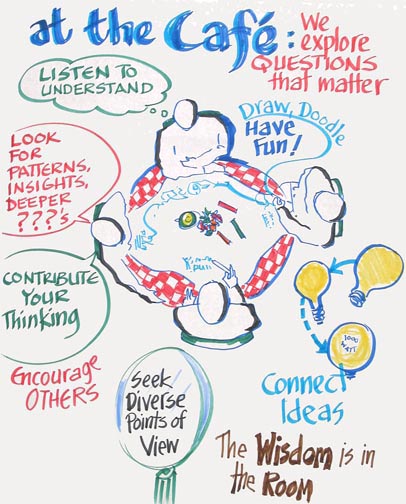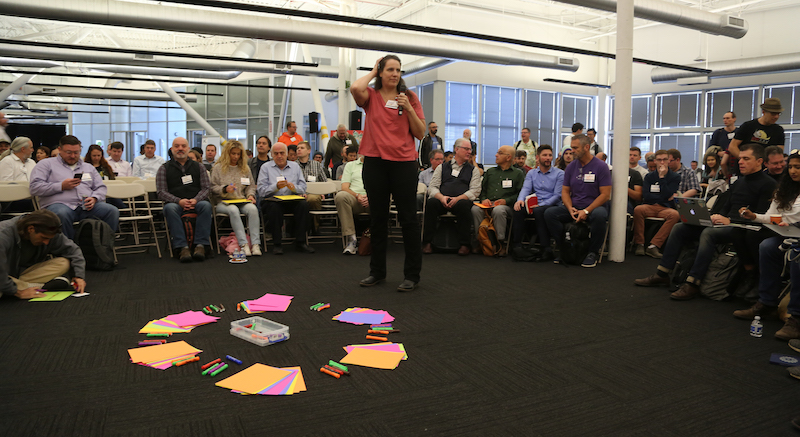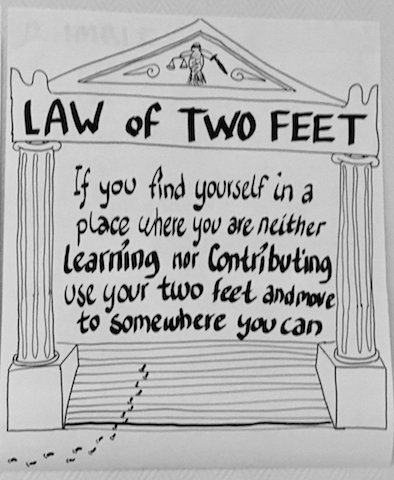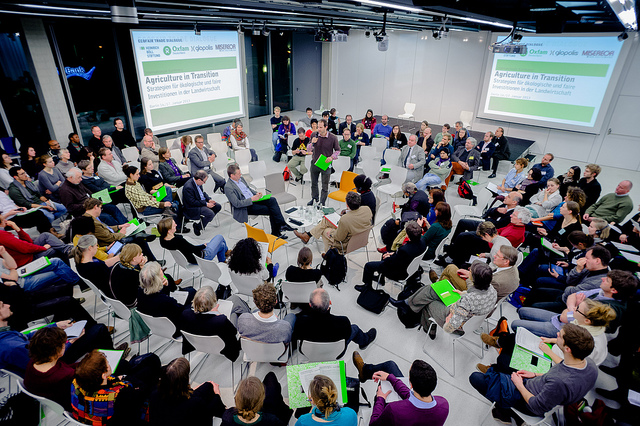When I first attended a meetup and heard the facilitator say “we’re going to open the café” I assumed they meant they were going to start serving the drinks provided for the event. Needless to say I felt a little silly once I realised what it was. Of course, it’s a name of a facilitation technique for large groups, of which there are many, but this post will focus on the ones I come across most often.
World Café
The World Café Method describes itself as “a simple, effective, and flexible format for hosting large group dialogue”. The naming comes from how it is structured - using small round tables with 4-5 chairs, similar to what you might find in a typical café, creating an intimate environment even at scale.

There are seven design principles for how the café should run:
- Set the Context - why you’re bringing people together, and what you want to achieve.
- Create hospitable space - an environment that feels safe and inviting to allow people to do their most creative thinking, listening and talking.
- Explore questions that matter - finding questions that are relevant to the real-life concerns of the group to attract discussions and insights.
- Encourage everyone’s contribution - allow participants not only to speak their mind and heart, but to listen to other participants.
- Connect diverse perspectives - create opportunities for people to move between tables with different themes or key ideas and meet new people.
- Listen together for patterns and insights - encourage people to listen for both what is being shared and what is not being spoken so they can pay attention to themes, patterns and insights of the whole group.
- Share collective discoveries - at the end of the café, allow a few minutes of silent reflection on the patterns, themes and deeper questions experienced in the small group conversations and call them out to share with the larger group. This final phase of the café is often referred to as the “harvest”.
Open Spaces
An Open Space can be used not only for hosting meetings or conferences, but also for symposiums or conflict resolutions. It focuses on self-organisation and is especially scalable and adaptable - used for groups of 5 to 2000+ people. The participants create and manage the agenda and take responsibility for facilitating all of the topics.

Open Space operates under four principles and one law. The four principles are:
- Whoever comes are the right people
- Whatever happens is the only thing that could have happened.
- When it starts is the right time
- When it’s over it’s over
The Law is known as the Law of Two Feet

The principles and law serve as the foundation of the open space - by participants feeling empowered to leave a session where they’re neither learning nor contributing, without feeling obliged to stay for the entire session, they can get much more out of the event.
How to run it
Although there are ten steps to running an Open Space event, the following elements must be included:
- Opening Circle - greeting, state the theme, overview of the open space and description of different break-out rooms available (if applicable)
- Facilitator’s explanation of the principles and law (mentioned above)
- Multiple conversations happening around the same space at the same venue at the same time (without the event facilitator assisting with each of those groups)
- Closing Circle - comments and reflection
The Open Space World’s website has tons of free resources to use to help you with planning and running an event.
Marketplace

The Marketplace is part of the Open Space. It is opened after the initial introductions are out of the way, and all participants are encouraged to contribute into creating the marketplace.
Essentially, there will be a board with a list of different locations and timeslots for the each session. Anyone can write a topic they’d like to facilitate on a post-it note along with their name. A queue is then formed, and the person who wrote the topic gets a short 30 second window to give an overview of their topic along with what timeslot they would like and in which room and the post-it is stuck to the correct section of the wallboard. If the same person has additional topics, they must join the back of the Marketplace queue to present their next topic.
Once everyone has presented their topics, the event Facilitator invites the entire group to sign up for sessions they are interested in and to take responsibility for their own schedule - using the aforementioned Law of Two Feet.
Fishbowl
Trying to facilitate open discussions when you have a large number of participants is difficult and usually only benefits a small number of attendees. The Fishbowl technique isolates the group so that a small number of 3-8 people are active participants in a discussion, with the remaining attendees observing the core group. This allows the facilitation to focus on the active discussion and tends to be much easier to handle. They’re useful for “hot topics” e.g. to estimate or not to estimate, or for sharing ideas from a variety of perspectives.

Fishbowls can be open or closed. The difference is simple: open Fishbowls have one or more free chairs for members of the audience who wish to make comments or ask questions to join. On the other hand, closed Fishbowls have no free chairs and audience members tend not to participate.
How to run it
As with any facilitation technique, there are variations that can be used, but generally a Fishbowl discussion will be 60 minutes, with an additional 10 minutes at the beginning to introduce the Fishbowl and the topic, and 20 minutes at the end to debrief. One variation to this might be to swap all the Fishbowl members after 10 minutes of discussion to cover more points of view.
Chairs are a must! Since the discussions will go on for some time, you want to ensure there’s enough chairs for all attendees to maintain engagement throughout. Ideally, the room should be large with plenty of wall space for flipcharts to capture the key points of the discussion. It’s also helpful to have 1-2 people supporting the lead facilitator who can capture these notes so that they can focus on the discussions happening.
Before the Fishbowl begins, the lead facilitator should introduce the ground rules. For example: no interrupting, respect the opinions of others, and respect the process as a whole. The topic for the discussion should be briefly presented or proposed (for example by the meeting organiser), and then the facilitator can help the participants to start the discussion. This should continue until either the allocated time for the discussion is nearing an end, or until the discussion dries up.
At the end, the facilitator should lead the debriefing where both the participants and observers can offer their final thoughts. The facilitation team (including flipchart noters) can summarise the discussion and ensure any decisions or actions are highlighted to take forward.
Which method works best?
It really depends on the scenario but I’ve mainly seen Open Spaces being used at Unconference events. World Cafés are also a common feature at meetup groups. In recent years I haven’t come across that many Fishbowls; they seem to be more common for debates and less used amongst the Agile community. The methods listed above are just a small subset of facilitation techniques - if you’re interested in seeing what others there are, I recommend you check out the wiki space on Knowledge Sharing Toolkit.